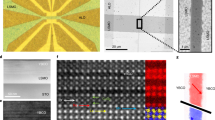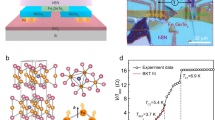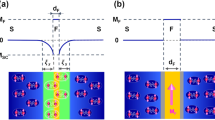Abstract
Conventional superconductivity is incompatible with ferromagnetism, because the magnetic exchange field tends to spin-polarize electrons and breaks apart the opposite-spin singlet Cooper pairs1. Yet, the possibility of a long-range penetration of superconducting correlations into strong ferromagnets has been evinced by experiments that found Josephson coupling between superconducting electrodes separated afar by a ferromagnetic spacer2,3,4,5,6,7. This is considered a proof of the emergence at the superconductor/ferromagnetic (S/F) interfaces of equal-spin triplet pairing, which is immune to the exchange field and can therefore propagate over long distances into the F (ref. 8). This effect bears much fundamental interest and potential for spintronic applications9. However, a spectroscopic signature of the underlying microscopic mechanisms has remained elusive. Here we do show this type of evidence, notably in a S/F system for which the possible appearance of equal-spin triplet pairing is controversial10,11,12: heterostructures that combine a half-metallic F (La0.7Ca0.3MnO3) with a d-wave S (YBa2Cu3O7). We found quasiparticle and electron interference effects in the conductance across the S/F interfaces that directly demonstrate the long-range propagation across La0.7Ca0.3MnO3 of superconducting correlations, and imply the occurrence of unconventional equal-spin Andreev reflection. This allows for an understanding of the unusual proximity behaviour observed in this type of heterostructures12,13.
This is a preview of subscription content, access via your institution
Access options
Subscribe to this journal
Receive 12 print issues and online access
$259.00 per year
only $21.58 per issue
Buy this article
- Purchase on SpringerLink
- Instant access to full article PDF
Prices may be subject to local taxes which are calculated during checkout




Similar content being viewed by others
References
Buzdin, A. I. Proximity effects in superconductor-ferromagnet heterostructures. Rev. Mod. Phys. 77, 935–976 (2005).
Keizer, R. S. et al. A spin triplet supercurrent through the half-metallic ferromagnet CrO2 . Nature 439, 825–827 (2006).
Anwar, M. S., Czeschka, F., Hesselberth, M., Porcu, M. & Aarts, J. Long-range supercurrents through half-metallic ferromagnetic CrO2 . Phys. Rev. B 82, 100501 (2010).
Khaire, T. S. et al. Observation of spin-triplet superconductivity in co-based Josephson junctions. Phys. Rev. Lett. 104, 137002 (2010).
Robinson, J. W. A., Witt, J. D. S. & Blamire, M. G. Controlled injection of spin-triplet supercurrents into a strong ferromagnet. Science 329, 59–61 (2010).
Sprungmann, D., Westerholt, K., Zabel, H., Weides, M. & Kohlstedt, H. Evidence for triplet superconductivity in Josephson junctions with barriers of the ferromagnetic Heusler alloy Cu2MnAl. Phys. Rev. B 82, 060505 (2010).
Senapati, K., Blamire, M. G. & Barber, Z. H. Spin-filter Josephson junctions. Nature Mater. 10, 849–852 (2011).
Bergeret, F. S., Volkov, A. F. & Efetov, K. B. Odd triplet superconductivity and related phenomena in superconductor-ferromagnet structures. Rev. Mod. Phys. 77, 1321–1373 (2005).
Eschrig, M. Spin-polarized supercurrents for spintronics. Phys. Today 64, 43–49 (January 2011).
Dybko, K. et al. Possible spin-triplet superconducting phase in the La0.7Sr0.3MnO3/YBa2Cu3O7/La0.7Sr0.3MnO3 trilayer. Phys. Rev. B 80, 144504 (2009).
Fridman, I., Gunawan, L., Botton, G. A. & Wei, J. Y. T. Scanning tunneling spectroscopy study of c-axis proximity effect in epitaxial bilayer manganite/cuprate thin films. Phys. Rev. B 84, 104522 (2011).
Kalcheim, Y., Kirzhner, T., Koren, G. & Millo, O. Long-range proximity effect in La2/3Ca1/3MnO3/(100)YBa2Cu3O7−δ ferromagnet/superconductor bilayers: Evidence for induced triplet superconductivity in the ferromagnet. Phys. Rev. B 83, 064510 (2011).
Sefrioui, Z. et al. Ferromagnetic/superconducting proximity effect in La0.7Ca0.3MnO3/YBa2Cu3O7−δ superlattices. Phys. Rev. B 67, 214511 (2003).
Blonder, G. E., Tinkham, M. & Klapwijk, T. M. Transition from metallic to tunneling regime in superconducting microconstrictions: Excess current, charge imbalance, and supercurrent conversion. Phys. Rev. B 25, 4515–4532 (1982).
Klapwijk, T. M. Proximity effect from an Andreev perspective. J. Supercond. Novel Magn. 17, 593–611 (2004).
Cirillo, C. et al. Superconducting proximity effect and interface transparency in Nb/PdNi bilayers. Phys. Rev. B 72, 144511 (2005).
Coey, J. M. D., Viret, M. & von Molnár, S. Mixed-valence manganites. Adv. Phys. 48, 167–293 (1999).
Eschrig, M. & Löfwander, T. Triplet supercurrents in clean and disordered half-metallic ferromagnets. Nature Phys. 4, 138–143 (2008).
Linder, J., Cuoco, M. & Sudbø, A. Spin-active interfaces and unconventional pairing in half-metal/superconductor junctions. Phys. Rev. B 81, 174526 (2010).
Van Zalk, M., Brinkman, A., Aarts, J. & Hilgenkamp, H. Interface resistance of YBa2Cu3O7−δ/La0.67Sr0.33MnO3 ramp-type contacts. Phys. Rev. B 82, 134513 (2010).
Tomasch, W. J. Geometrical resonances and boundary effects in tunneling from superconducting. Phys. Rev. Lett. 16, 16–19 (1966).
McMillan, W. L. & Anderson, P. W. Theory of geometrical resonances in the tunneling characteristics of thick films of superconductors. Phys. Rev. Lett. 16, 85–87 (1966).
Rowell, J. M. & McMillan, W. L. Electron interference in a normal metal induced by superconducting contacts. Phys. Rev. Lett. 16, 453–456 (1966).
Rowell, J. M. Tunneling observation of bound states in a normal metal-superconductor sandwich. Phys. Rev. Lett. 30, 167–170 (1973).
Koren, G., Polturak, E. & Deutscher, G. Oxygen-controlled transition from tunnel-like to a weak-link behavior in YBa2Cu3O7−d/YBa2CoCu2Oy/YBa2Cu3O7−δ wedge-edge junctions. Physica C 259, 379–384 (1996).
Nesher, O. & Koren, G. Observation of Tomasch oscillations and tunneling-like behavior in oxygen-deficient edge junctions. App. Phys. Lett. 74, 3392–3394 (1999).
Nesher, O. & Koren, G. Measurements of Δ and vF from Andreev reflections and McMillan-Rowell oscillations in edge junctions of YBa2Cu3O6.6/YBa2Cu2.55Fe0.45Oy/YBa2Cu3O6.6 . Phys. Rev. B 60, 9287–9290 (1999).
Singh, D. J. & Pickett, W. Pseudogaps, Jahn-Teller distortions, and magnetic order in manganite perovskites. Phys. Rev. B 57, 88–91 (1998).
Hass, N. et al. Sharp gap edge and determination of the Fermi velocity in Y1Ba2Cu3O7−δ by point contact spectroscopy. J. Supercond. 5, 191–194 (1992).
Hoffmann, A. et al. Suppressed magnetization in La0.7Ca0.3MnO3/YBa2Cu3O7−δ superlattices. Phys. Rev. B 72, 140407 (2005).
Acknowledgements
J.E.V. and C.V. wish to thank J. M. Rowell, A. Goldman and S. Maekawa for fruitful discussions. We thank C. Deranlot for Au deposition, D. Deneuve for technical support for the lithography process and C. Collet for focused ion beam and scanning electron micrographs. This work was supported by French ANR grant ‘SUPERHYBRIDS-II’ and RTRA grant ‘Supraspin’, European Community’s FP7/2010 ‘Pixie’, Spanish MICINN Grants MAT 2011 27470, CSD2009-00013 (IMAGINE) and CAM S2009-MAT 1756 (PHAMA).
Author information
Authors and Affiliations
Contributions
J.E.V., J.S. and A.B. conceived the experiments. C.V. and J.T. grew the samples.C.V. performed the lithography processes. C.V., J.E.V. and Z.S. carried out transport experiments. C.V. analysed the data. C.V. and J.E.V. wrote the paper. All of the authors contributed to the discussion leading to the understanding of the data and contributed to the preparation of the manuscript.
Corresponding author
Ethics declarations
Competing interests
The authors declare no competing financial interests.
Supplementary information
Supplementary Information
Supplementary Information (PDF 741 kb)
Rights and permissions
About this article
Cite this article
Visani, C., Sefrioui, Z., Tornos, J. et al. Equal-spin Andreev reflection and long-range coherent transport in high-temperature superconductor/half-metallic ferromagnet junctions. Nature Phys 8, 539–543 (2012). https://doi.org/10.1038/nphys2318
Received:
Accepted:
Published:
Issue date:
DOI: https://doi.org/10.1038/nphys2318
This article is cited by
-
Extremely long-range, high-temperature Josephson coupling across a half-metallic ferromagnet
Nature Materials (2022)
-
Evidence for anisotropic spin-triplet Andreev reflection at the 2D van der Waals ferromagnet/superconductor interface
Nature Communications (2021)
-
Triplet superconductivity in coupled odd-gon rings
Scientific Reports (2019)
-
Anomalous anisotropic behaviour of spin-triplet proximity effect in Au/SrRuO3/Sr2RuO4 junctions
Scientific Reports (2019)
-
Growth and Nanofabrication of All-Perovskite Superconducting/Ferromagnetic/Superconducting Junctions
Journal of Superconductivity and Novel Magnetism (2019)



